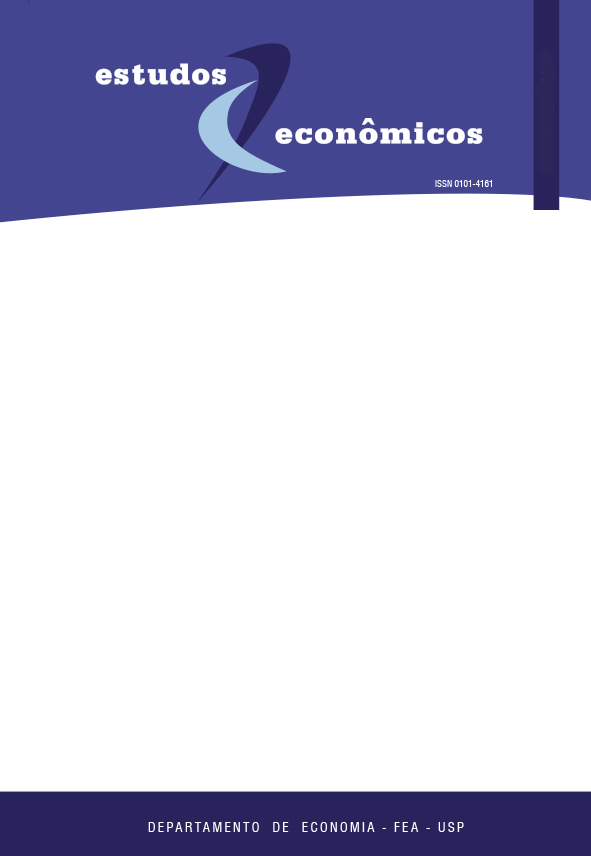Acumulação de capital, restrição externa, hiato tecnológico e mudança estrutural: teoria e experiência brasileira
DOI:
https://doi.org/10.1590/S0101-41612012000100006Keywords:
structural change, technological progress, industrialization, external restrictionAbstract
The periods of fast growth in the Brazilian economy from the post-war until the end of the 1970s have been constrained by imbalances in the foreign sector. We propose in this paper a model, based on Kaldor, where capital accumulation, technological gap and long run external constrain are connected. Our hypothesis is that capital accumulation, under certain circumstances, can overcome external constrain if the accumulation effort promotes structural change increasing the importance of sectors technological-intensive. It is expected that the structural change in this direction will contribute to an increase in the income-elasticity of exports and to a decrease in income-elasticity of imports, resulting in the increase in the growth rate of real product compatible with the balance of payments equilibrium in the long run. The last part of the paper shows that the high investment rate observed in the Brazilian economy from the post-war period until the end of the 1970s resulted in the deepening of the import substitution process, what, in our interpretation, contributed to partially increase the long run growth rate of the Brazilian economy compatible with the balance of payment equilibrium.
Downloads
References
Atesoglu, H.S. (1997). Balance of Payments-Constrained Growth Model and Its Implications for the U.S. Journal of Post Keynesian Economics, Vol. 19, n.3.
BCB: Balanço de Pagamentos
Castro, A. B. e Souza, F. E. P. (2004). A economia Brasileira em marcha forçada, Editora Paz e Terra, 3ª. ed.
Castro, A B. (2008). From Semi-stagnation to Growth in a Sino-centric Market. Revista de Economia Política, 28 (1).
Cimoli, M (2005). Heterogeneidad Estructural, Asimetrías Tecnológicas y Crecimiento en América Latina, CEPAL.
Cimoli, M., Porcile, G., Primi, A. e Vergara, S. (2005). Cambio Estructural, Heterogeneidad Productiva y Tecnología en América Latina. In: Cimoli, M. (editor) Heterogeneidad estructural, asimetrías tecnológicas y crecimiento en América Latina, CEPAL.
Domar, E. (1946). Capital Expansion, Rate of Growth and Employment. Econométrica, vol. 14, pp 137-147.
Dosi, G., Pavitt, K.; Soete, L. (1990). The Economics of Technical Change and International Trade, New York University Press.
Dutt, A.K. (2003). Income Elasticity of Imposts, North-South Trade and Uneven Development. In: Dutt, A.K; Ros, J. (orgs.). Development Economics and Structuralist Macroeconomics. Edward Elgar: Aldershot.
Fagerberg, J. (1988) Why Growth Rates Differ. In: Dosi, G et al. (orgs.). Technical Change and Economic Theory. Pinter Publishers: Londres.
Fajnzylver, F. (1983) La Industrialización trunca de América Latina. Editorial Nueva Imagem, México.
Fajnzylber, F (2000) O Conjunto Vazio, em Cinqüenta anos de Pensamento na Cepal. Org, Bielschowky, R. Editora Record, volume 2.
Foley, D; Michl, T. (1999). Growth and Distribution. Harvard University Press: Cambridge (Mass).
Furtado, C (1984) Cultura e Desenvolvimento em Época de Crise. Editora Paz e Terra, Rio de Janeiro.
Furtado, C [1952](2010) Formação de Capital e Desenvolvimento Econômico, em A Economia do Subdesenvolvimento. Org: Agarwala, A.N. e Singh, S.P. Editora Contraponto, Rio de Janeiro. Centro Internacional Celso Furtado.
Harrod, R (1933) International Economics, Cambridge, Cambridge University Press.
Harrod, R (1939). An Essay in Dynamic Theory. The Economic Journal, vol. 49, 1939.
Holland, M; Porcile, G (2005). Brecha Tecnológica y Crecimiento en América Latina. In Cimoli, M. (org.) Heterogeneidad estructural, asimetrías tecnológicas y crecimiento en América Latina, CEPAL.
IBGE: Contas Nacionais, sistema consolidado.
IBGE: Censo Industrial de 1970 e 1985
Kaldor, N. (1957) A Model of Economic Growth. Economic Journal.
Kaldor, N; Mirrlees, J.A. (1962). A New Model of Economic Growth. Review of Economic Studies, 29.
Marquetti, A (2004). Do rising Real Wages Increase the Rate of Labor-Saving Technical Change? Some Econometric Evidence. Metroeconomica, Vol. 55, N.3.
McCombie, J.L; Roberts, M. (2002). The Role of the Balance of Payments in Economic Growth. In Setterfield, M. The Economics of Demand-led Growth: Challenging the supply-side vision of the long run. Edward Elgar.
Moreno-Brid, J.C. (1998-1999). On Capital Flows and the Balance of Payments Constrained Growth Model. Journal of Post Keynesian Economics, Vol. 21, N.2.
Prebisch, R. (2000) Problemas Teóricos e Práticos do Crescimento Econômico, em Cinqüenta anos de Pensamento na Cepal. Org, Bielschowky, R. Editora Record, volume 1.
Rodriguez, O. (2009). O Estruturalismo Latino-Americano. Civilização Brasileira: Rio de Janeiro.
Tavares, M.C.(1976) Da Substituição de Importações ao Capitalismo Financeiro: ensaios sobre economia brasileira. Zahar Editores, Rio de Janeiro.
Thirlwall, A.P (1979). The Balance of Payments Constraint as an Explanation of International Growth Rates. Banca Nazionale del Lavoro. Quarterly Review, March.
Thirlwall, A.P(1997). Reflections on the Concept of Balance of Payments Constrained Growth. Journal of Post Keynesian Economics
Thirlwall, A.P (2001). The relation between the warranted growth rate, the natural growth rate and the balance of payments equilibrium growth rates. Journal of Post Keynesian Economics.
Verspagen, B (1993). Uneven Growth Between Interdependent Economies. Avebury: Aldershot.
Downloads
Published
Issue
Section
License
Copyright (c) 2012 Marcos Tostes Lamonica, José Luis da Costa Oreiro, Carmem Feijó

This work is licensed under a Creative Commons Attribution-NonCommercial 4.0 International License.
By submitting an article, the author authorizes its publication and attests that it has not been submitted to any other journal. The original article is considered final. Articles selected for publication are proofread for grammatical and orthographic errors. The journal does not pay rights for published articles. The Institute of Economic Research from the School of Economics, Business and Accounting of the University of São Paulo (Instituto de Pesquisas Econômicas da Faculdade de Economia, Administração e Contabilidade da Universidade de São Paulo) owns the journal's copyright.




